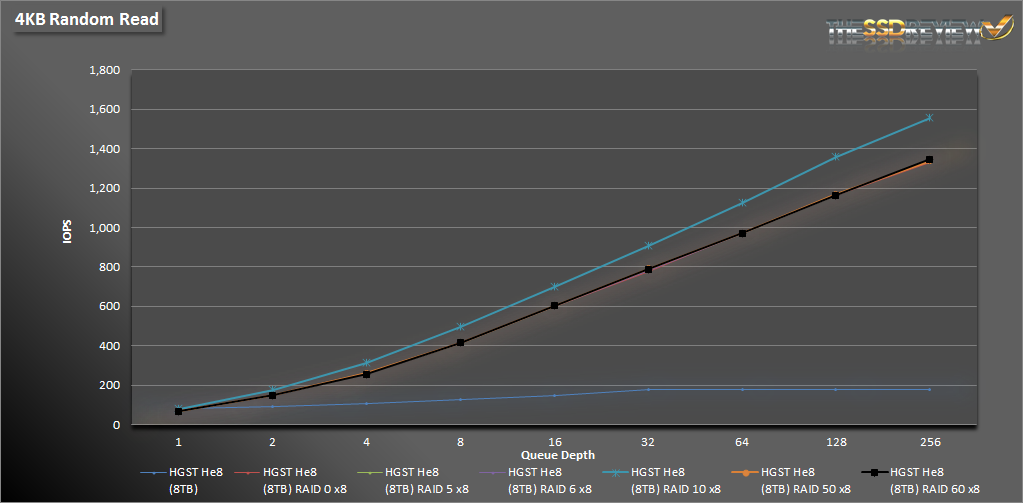MEASURING PERFORMANCE
How we start to get a look at RAID performance as well as single drive performance. As with all of our tests, the following tests were performed across the entire span of the drive.
 Random 4K reads max out at 175 IOPS at QD 32 for a single drive, however, in a RAID 10 config’s IOPS continue to climb to nearly 1,600 at QD 256. All the other RAID arrays perform pretty much the same, a bit lower performance than RAID 10 in this metric.
Random 4K reads max out at 175 IOPS at QD 32 for a single drive, however, in a RAID 10 config’s IOPS continue to climb to nearly 1,600 at QD 256. All the other RAID arrays perform pretty much the same, a bit lower performance than RAID 10 in this metric.
As a single drive it reaches a max of 300 IOPS at a QD of 16. During random 4K writes we start to see some more differentiation. RAID 0 performs the best reaching 2,500 IOPS. RAID 10 is next followed by RAID 5 and 50. Lastly RAID 6 and 60 are near the performance of a single drive.
 Again, RAID 10 proves to deliver the best read performance in small file transfers while the other RAID types display similar performance. As a single HDD, the Ultrastar He8 reaches 175 IOPS during 8K random reads.
Again, RAID 10 proves to deliver the best read performance in small file transfers while the other RAID types display similar performance. As a single HDD, the Ultrastar He8 reaches 175 IOPS during 8K random reads.
In 8K random writes the single drive reaches 288 IOPS. Topping out in write performance again is RAID 0, followed by RAID 10 at half its IOPS. RAID 5, 50, 6, and 60 results range from about 330 IOPS to 530 IOPS.
 Now, finally taking a look at sequential performance we can see a bit of a different trend. While RAID 0 and 10 are still on top, RAID 5’s performance is a bit higher than the RAID 50 results, which are now on par with RAID 6 results. However, this changes when we look at writes, where RAID 10’s performance plummets to where RAID 60 performs. As a single drive, the He8 reaches 209MB/s read and write, 4MB/s higher than the spec of 205MB/s.
Now, finally taking a look at sequential performance we can see a bit of a different trend. While RAID 0 and 10 are still on top, RAID 5’s performance is a bit higher than the RAID 50 results, which are now on par with RAID 6 results. However, this changes when we look at writes, where RAID 10’s performance plummets to where RAID 60 performs. As a single drive, the He8 reaches 209MB/s read and write, 4MB/s higher than the spec of 205MB/s.
 The SSD Review The Worlds Dedicated SSD Education and Review Resource |
The SSD Review The Worlds Dedicated SSD Education and Review Resource | 
